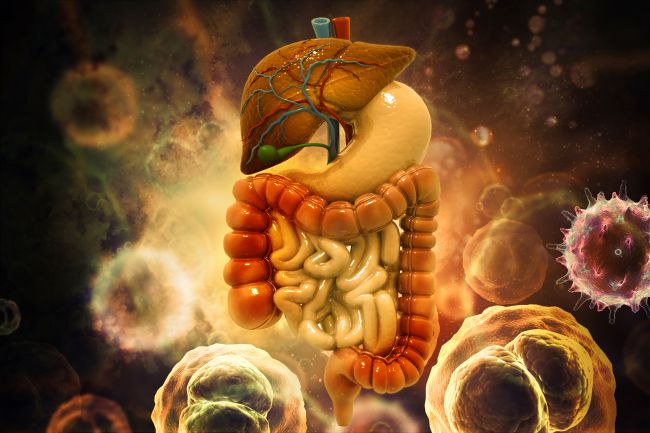
How A Leaky Gut Damages Our Liver
Let me start by saying leaky gut is a term which I hate. This topic has certainly irritated the medical profession too, with doctors for years shunning anyone who suggested that leaky gut happens. Quick qualifier at this stage – our gut is supposed to be leaky! It must allow the nutrients we need enter into circulation, but whilst keeping bacteria firmly in the digestive tract. When the gut lining becomes excessively leaky or hyperpermeable (my preferred term for leaky gut), bacteria and bacterial metabolites cross into the bloodstream. It turns out that is not good for our health in many ways, including the liver.
Non-alcoholic fatty liver disease, or NAFLD, is a progressive liver disease where fat accumulates in the liver. It’s very common, with a prevalence of approximately 25% in the population of the European Union (1). Over time, NAFLD can lead to excessive inflammation and scarring known as non-alcoholic steatohepatitis (NASH) or further to cirrhosis where there is permanent liver scarring. The progression and symptomology of NAFLD is identical to alcohol-related liver disease (ARLD).
Symptomology differs between the different stages. Often, at the early stages, NAFLD presents with no overt symptoms. However, over time, as one progresses to NASH and cirrhosis, liver function decreases with an elevation of liver enzymes (ALT, AST) and inflammatory markers. So we can all agree that NAFLD is not good and something to avoid. Not surprisingly, risk factors for NAFLD include obesity, type 2 diabetes, and age. There are no pharmaceutical treatments for NAFLD, but weight loss is very effective. Weight reduction of 5-10% leads to reductions in liver fat.
Recently, several studies indicate that increased intestinal permeability, or leaky gut, may play a significant role in NAFLD. This may explain why NAFLD is similar to ARLD, as alcohol increases intestinal permeability.
Leaky Gut and Liver Damage
How a leaky gut damages our liver has been hard to explain. But several lines of evidence indicate that people with NAFLD and NASH have greater exposure of lipopolysaccharide (LPS) to the liver (2, 3). LPS is a component of the cell wall of certain types of bacteria that reside in our gut. Under increased intestinal permeability, these bacteria enter circulation and go to the liver. In the liver, LPS activates a receptor called toll-like receptor 4 (TLR-4), causing inflammation.
But how does this process lead to fatty liver? A recent experiment identified a potential cause. Researchers found that autophagy, a process that degrades damaged cellular components (I have talked about the importance of this in my aging blogs), follows a circadian rhythm. In a healthy mouse liver, components in a part of the cell called the cytosol and nucleus are degraded during the day. But components in the mitochondria, a part of our cell that produces energy from our food and oxygen, are degraded at night (learn more about mitochondria in my blog here). However, when exposed to LPS, the mitochondria are perpetually targeted. (4)
Persistent degradation of mitochondria leads to an inability to metabolise fat. Over time, this can lead to accumulation of fat in the liver. Furthermore, this leads to a build up of enzymes in the cytosol that process glucose and may lead to elevations in blood glucose. This may explain the relationship with NAFLD, obesity, and type 2 diabetes and why fat loss is the best therapeutic option to address it.
Lifestyle Holds the Secret To Avoiding Liver Damage
How leaky gut damages our liver is now becoming much clearer. Recent evidence indicates that increased intestinal permeability may play a causal role in the development of NAFLD. NAFLD presents a substantial health burden throughout the developed world. Lives and money could be saved by reducing its impact. Primarily driven by lifestyle, weight loss is effective at stopping and reversing progression of NAFLD.
Factors associated with lifestyle that also address gut health such as avoidance of a western diet, increased intake of fiber (5), and reduced meal frequency (6) may provide additional benefits in addition to weight loss. These habits along with minimising consumption of alcohol can help to reduce the risk of gut hyperpermeability as well as many other chronic diseases.
If you are interested in measuring leaky gut or any further part of the article, you can contact Graeme on info@nordicclinic.se.
References
1. https://www.ncbi.nlm.nih.gov/pmc/articles/PMC7063528/
2. https://www.mdpi.com/2072-6643/12/9/2762
3. https://pubmed.ncbi.nlm.nih.gov/31808577/
4. https://www.cell.com/cell-reports/pdf/S2211-1247(19)30101-9.pdf

